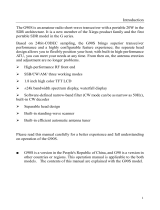
Click here for a
video overview
of the Icom
IC-7300 HF and
6 meter
transceiver.
prefer to continue using it instead, don't
worry. The IC-7300 still offers a multipin
accessory port on the rear panel to ac-
commodate your interface connections.
About that Screen
I quickly learned to love the IC-7300's
touchscreen. It is bright and easy to read,
including the waterfall and spectrum scope
(see Figure 6). Both scopes are adjustable
and you can even zoom in for a closer look
at individual signals, or select an additional
display of the audio characteristics of the
signal. (This was particularly helpful when
sending PSK31. I could see the modulation
characteristics of my transmit signal right
there on the screen.) Tapping a signal on
the scope tunes the transceiver to that fre-
quency. Even passband tuning is rendered
graphically. When you twist either of the
passband tuning knobs, you see the result
as an animated graphic that shows the ef-
fect of what you are doing.
While exploring the myriad features, I also
ran across a very cool SWR graphing func-
tion that behaves like an antenna analyzer.
You set your frequency parameters and then
repeatedly press the TRANSMIT button.
With each press, the SWR is measured and
plotted on the graph (see Figure 7). This is a
good time to mention that while the built-in
antenna tuner is designed for mismatches
that result in a maximum 3:1 SWR, it offers
a so-called "Emergency Mode" that allows
it to grapple with SWRs as high as 10:1,
albeit at reduced RF output.
Overall, the screen was well suited to my
needs, even with my aging vision, but if
you want something bigger, Icom offers
the optional $100 RS-BA1 remote control
software. With this software you can con-
trol the transceiver and display the entire
screen on your computer monitor. You
can even control the IC-7300 remotely via
the Internet.
Conclusion
So is the IC-7300 really a game-changer?
In my opinion, it clearly meets the criteria.
The IC-7300 takes the familiar ergonomic
design of an analog transceiver and blends
it seamlessly with software defined radio
technology — all at a moderate price. I
have a feeling that this approach to amateur
transceiver design is likely to spread rap-
idly, even to lower-end models. Years from
now we may look back at the IC-7300 and
see its introduction as the moment when
everything changed.
Manufacturer: Icom America, 12421 Wil-
lows Road NE, Kirkland, WA 98034; tel
800-872-4266; www.icomamerica.co
THE NETHERLANDS | Roermond
Tel. +31 (0)475-327390
www.classicinternational.eu
GERMANY | Mönchengladbach
Tel. +49 (0)2166-33061
www.classicinternational.eu









